MCAT Sociology
1/339
There's no tags or description
Looks like no tags are added yet.
Name | Mastery | Learn | Test | Matching | Spaced |
|---|
No study sessions yet.
340 Terms
Conflict Theory Overview
Emphasizes the significance of unequal power and conflict in society
Says conflict can be a good thing because it leads to change
Conflict Theory Descriptive
The essence of social life is that people and groups are caught up in power struggles
Conflict Theory Explains
There are limited resources and people in power tend to retain and protect their power, usually at the expense of others
Conflict Theory Predicts
Conflicts will always exist
They can be constructive or destructive
Symbolic Interactionism Overview
Humans learn to interpret the world through interactions
They then organize their lives around these socially created meanings
Symbolic Interactionism Descriptive
The essence of social life is cultural
Shared languages, belief systems, and customs
Symbolic Interactionism Explains
Humans are inherently designed to seek meaning, connection and communication
Symbolic Interactionism Predicts
Some customs will be passed down over generations
Cultures will continue to blend with one another
New customs will arise
Structural Functionalism Overview
Societies seek equilibrium, and the whole is greater than the sum of the part
Structural Functionalism Descriptive
Humans are inherently cooperative and practice complex divisions of labor
Structural Functionalism Explains
Because we need one another to obtain food, shelter, and to carry out projects
Structural Functionalism Predicts
The division of labor will intensify
As societies change, each subgroup will have to adapt to reattain equilibrium
Social Constructionism
Our sense of reality comes from jointly constructed understanding of the world
Social Imagination
Perspective that individuals and groups always affect one another across situations
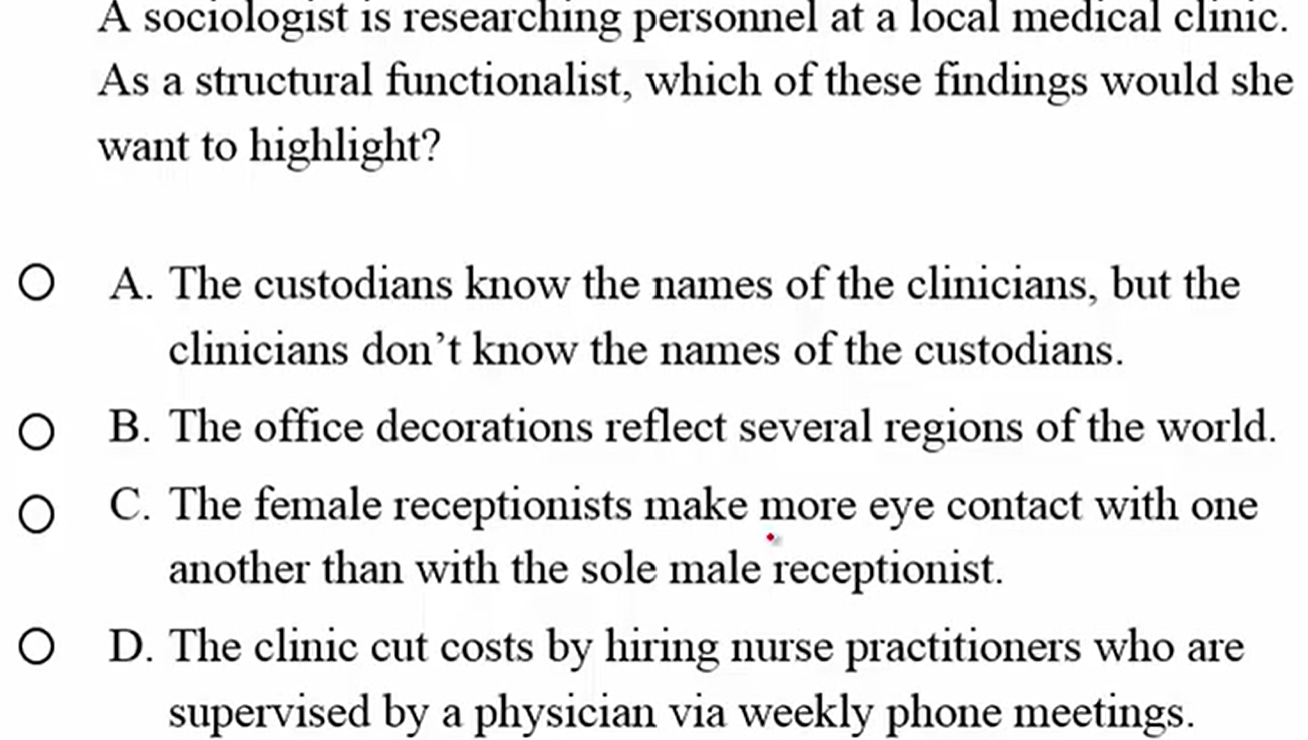
D. The clinic cut costs by hiring nurse practitioners who are supervised by a physician via weekly phone meetings
Division of labor and how separate pieces fit together
A and C are symbolic interaction or conflict theory
B is a maybe but not quite
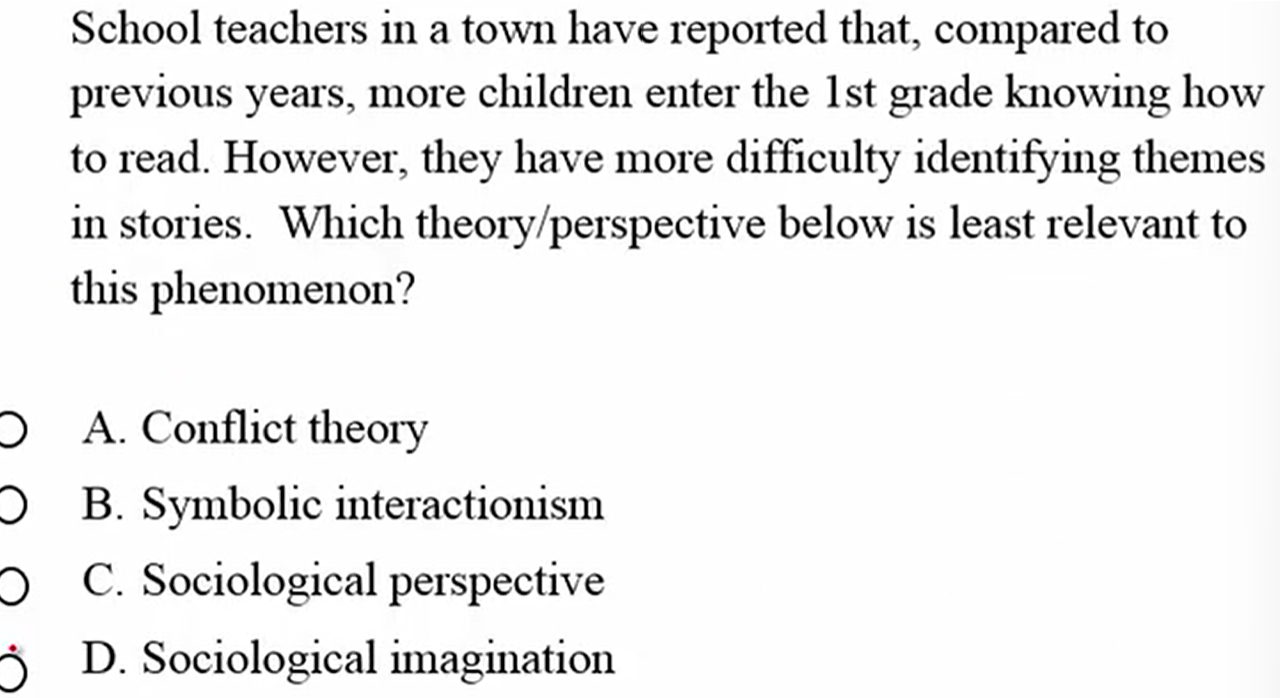
A. Conflict Theory
Social Exchange Theory (SET)
Relationships are negotiated through cost-benefit analyses
Uses economic principles to explain human behavior
Exclusively focuses on building and terminating relationships
Rational Choice Theory (RCT)
Argues that people make decisions based on what makes sense to them
People are rational
Goal-oriented
Reflective
Consistent
Encompasses all sorts of human behaviors and decisions
Theorists are interested in how people make decisions NOT random/impulsive behaviors
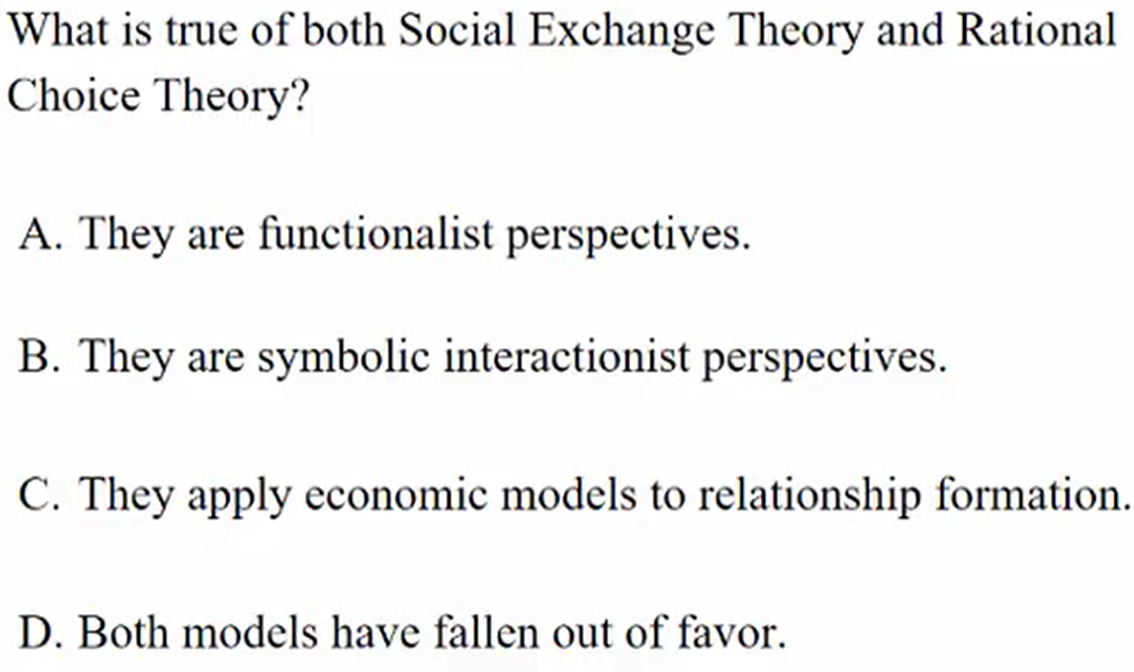
C. They apply economic models to relationship formation
Culture
The tools and practices of a group of people who share beliefs and carry out their daily lives through similar routines
Encoded in materials (tools, technology, food) and symbols (language, gestures, beliefs)
All cultures contain:
Beliefs
Language
Rituals
Symbols
Values
Subculture
Population subset with unique interests and a lifestyle that set them slightly apart from the larger culture
Counterculture
Operate within society but defied dominant values
Cultural Transmission
Teaching cultural practices to people within your own culture
Cultural Transfusion
The spreading of cultural practices from one culture to another
Assimilation
Idea that immigrants will eventually conform to the culture where they now live
Multiculturalism
Idea that cultures are always blending and exchanging practices in a dynamic way
Cultures influence one another
Ehtnocentricism
Negatively judging cultural practices that differ from your own
Relativism
Assessing people and practices through their cultural values rather than one’s own
Each society should be judged to that society’s cultural norms rather than to a universal code of conduct
Culture Shock
Anxiety and disorientation that occur when immersed in an unfamiliar culture
Culture Lab
Technology changes before values have a chance to catch up
Hunting Gathering
Small groups
Nomadic
Leadership was based on seniority in extended families
Pastoral
Larger groups, herd livestock, headed by chiefs
Agrarian
Villages, agricultural, not very nomadic, headed by chiefs or kings
Early Civilizations
Spread over vast regions, written languages exists, headed by kings or emperors
Longest historically recorded type of society in which humans have lived:
Hunter and gathering (first and longest)
Agricultural
Pastoral
information
Nation State
Communities with political boundaries
Economically Developed (Post-Industrial) Nation States
Formal, complex institutions
High levels of consumption
Less Economically Developed Nation States
Factories
Production
Formal system of social services
Under Economically Developed Nation States
Mostly rural
Few schools, hospitals, etc.
Little money
Industrialization
Began in Britain 250 years ago
Rise in technology, communication, organizational complexity
Stereotype
Overgeneralization about a group of people
Can be positive or negative
Self-fulfilling prophecy
Over time, many people begin to act in accordance with the stereotypes others have of them because it’s easier than fighting social expectations
Stereotype Threat
Phenomenon by which, when people are made aware of their group membership before performing a task, their performance suffers
Bias
A tendency to prefer one thing over another tot he point of not being objective
Prejudice
Negative outlook on a person or situation based on preconceived beliefs
Discrimination
Negative actions taken against people (or failing to take positive actions)
The role of cognition and emotion in prejudice and discrimination
People who think in linear, systematic ways are more likely to be prejudice
Hypothesis of relative deprivation
When people see others with something they want, and they feel blocked from obtaining it, they are likely to act out
Prosocial (social movements) or Antisocial (violence, vandalism)
Acculturation
The process of physical, social, and psychological adaptation to a new culture
Diaspora
The breakup of a group as the members disperse from their homeland
Enculturation
The process of learning the culture in which an individual is raised
Secularization
Adopting changes that are free of the influences of religion
Macrosociology
The power distribution within a society and focuses on systems and social conditions on the largest scale, such as cities and churches
Always in the perspective of the entire society
Microsociology
The study of each individual in a society
Morphology
The forms and structure of the organism
Ethnomethodology
The analysis of people’s daily engagement in society
Cultural Universals
Patterns or traits that are globally common to all societies
Socialization
The lifelong process through which a person becomes an active participant in their culture (language, customs, values)
Cannot be socialized if you don’t have a self (infants under 1)
Selves develop through socialization
Agents of Socialization
Family
Schools/Workplace
Peers
Media
Impart values, beliefs, and social norms
Imitation and Mirror Neurons
Humans begin imitating others in infancy
Primates have neurons that fire when performing an action or watching another animal perform that same action
Mirror neurons are located in the inferior frontal lobe and superior parietal lobe
Looking-Glass Self
A theory stating that people’s identities are shaped by the perception of others
Reference Groups
Any group a person compares themselves to
Associative Reference Groups
Groups we belong to
Aspirational Reference Groups
Groups we admire but don’t belong to
Dissociative Reference Groups
Groups we don’t want to belong to
Primary Groups
Groups we strongly identify with; persist across years
Secondary Groups
Groups we identify with for a short while
Outgroups
Any group we see as “not us”
Macro
Demographic
Meso/Micro
Dissociative and Outgroup Distinction
ALL dissociative reference groups are outgroups
NOT ALL outgroups are dissociative groups
Vygotsky’s Sociocultural Theory Take-Home Idea
Although one’s identity feels very unique and inherent, it’s strongly shaped by the environment
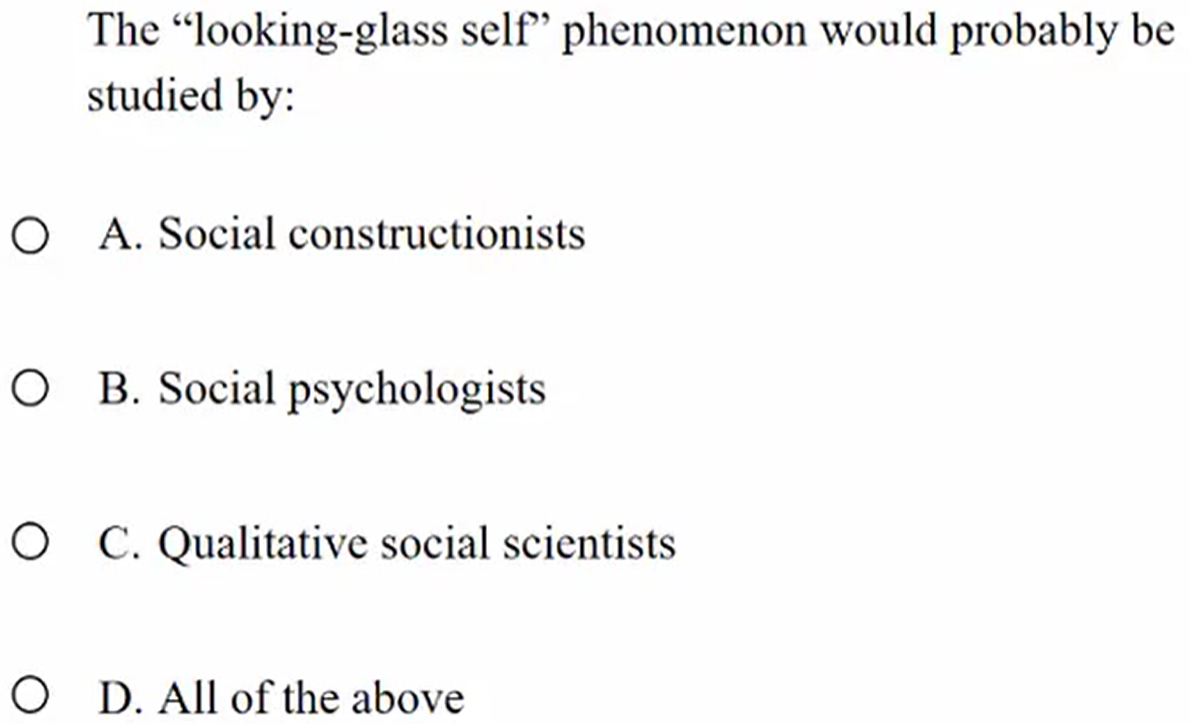
D. All of the above
Social Facilitation Definition
People perform more quickly and accurately when others are present
Plays a role even when people are thinking about imaged audiences
Two Types of Social Facilitation
Co-action effects (side-by-side behavior)
Audience effect (behavior in front of a passive audience)
Social Inhibition
If you lack confidence or practice, the presence of others will HINDER your performance
Deindividuation
People in groups lose self-awareness and thereby take part in behaviors they normally wouldn’t
Social Loafing
For some tasks, people exert less individual effort when a group is working towards a common goal due to “diffusion or responsibility”
More likely when group size is large and task is perceived as unimportant
The Bystander Effect
People are less likely to help a victim if other potential helpers are present
NOT the same as social loafing
Know the issue is important and are distressed by it
Individuation
The process of becoming a unique, semi-autonomous self
Occurs throughout life but mostly in childhood
Identity Categories
Self-concepts (memories, beliefs, and evaluations about our tendencies and personalities)
Social identities (groups we identify with)
Self-Concept
Self-Schema
Self-Evaluations
The combination of the two results in multiple “selves”
Self-Schemas
A set of relatively stable memories about ourselves that enable us to reflect upon our personalities
We draw upon these memories to come to conclusions about who we are
Self-Evaluations
Our judgments about ourselves
Accompany comparisons and value judgments
Ideal Self
The self we wish we were
Actual Self
The self we believe we are
Ought Self
The self we believe that others want us to be
Social Identities
Emanate from our:
Group Memberships
Social Positions
Group Memberships
Groups we belong to, either by choice or by circumstance or heritage
More frequently refers to demographic
Social Positions
Our roles and statuses in relation to our group memberships
Self-Esteem
Positive or negative regard for oneself
People with high self-efficacy and internal locus of control tend to have a higher self-esteem
Self-Efficacy
One’s perceived ability to accomplish a task or be effective in the world
Can be specific to a domain or more general “life skills”
Internal Locus of Control
The belief that one’s own actions are largely to credit and blame for what happens in their life
External Locus of Control
The belief that what happens in one’s life is beyond individual control (attributes outcomes to fate, other people, luck, or other outside events)
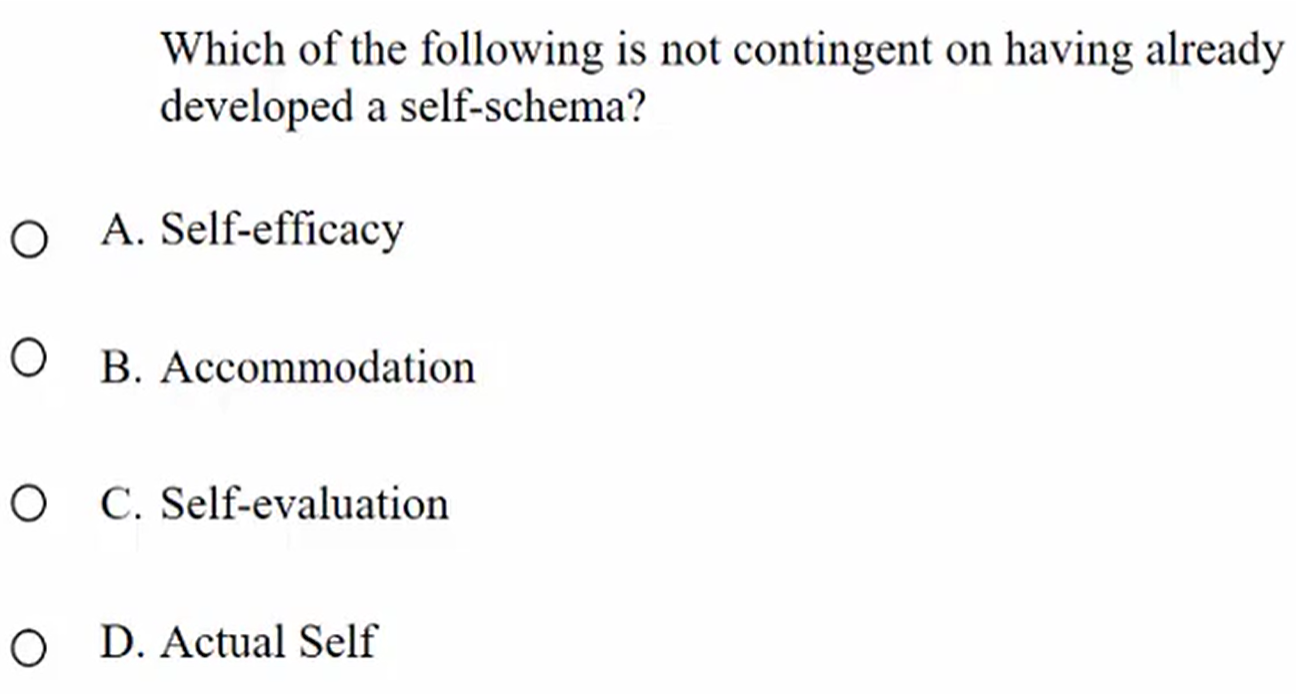
B. Accommodation
Accommodation Definition: Individual makes room for some kind of new information that they’ve come across
Question is asking which of the 4 could develop a self-schema: belief about one’s identity at large
Status
Social position we occupy
Ascribed
Achieved
Ascribed Status
Category we fill based on our life situation
Achieved Status
Status we obtain based on our choices, abilities, and focused action
Role
Behaviors expected of us based on our status
Role SEt
The multiple roles attached to a specific person
Role Exit
When a person has to abandon a role they still feel ties to in order to take on another role